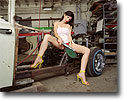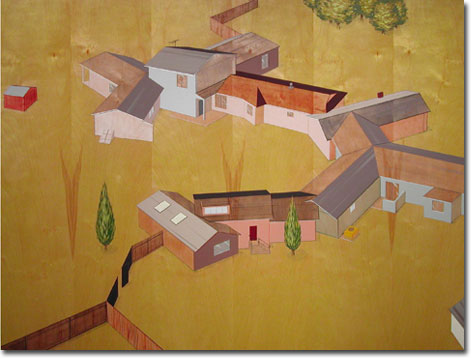Yerba Buena Center for the Arts,
Jul 16, 2005 - Nov 06, 2005
San Francisco, CA, USA
Are we done yet?
by María del Carmen Carrión
Featuring work by: Chris Ballantyne, Tommy Becker, Libby Black, Liz Cohen, Adriane Colburn, Gestalt Collective, Robert Gutierrez, Hamburger Eyes, John Hattori, Marisa Jahn & Steve Shada, Xylor Jane, Jim Jocoy, Helena Keeffe, Chris Kubick & Anne Walsh, Frederick Loomis, Michelle Lopez, Mail Order Brides/m.o.b., Ari Marcopoulos, Christian Maychack, Keegan Mchargue, Apollonia Morrill, Neck Face, Sasha Petrenko, Kate Pocrass, Emily Prince, Ted Purves, Christine Shields, Stretcher, Josephine Taylor, Margaret Tedesco, Hank Willis Thomas, Edie Tsong, Anna Von Mertens. How are mythologies constructed? I’m both asking and thinking out loud. Is it the institution that names a local scene with a specific label (youth culture, social practice, community oriented)? Or is it the overwhelming evidence and activity of a place? Trying to both map a region and give a name to its characteristics becomes an open trap in Bay Area Now 4, Yerba Buena Center for the Arts’ triennial of emerging contemporary art. Co-curators René de Guzman and Berin Golonu emphasize collaborative, community oriented strategies as one of the common threads in the works and art practices produced in the area. The curatorial effort however, of presenting artists and artists’ collectives working in socially engaged methods, falls flat. Not every form of collaboration entails a social practice, and not all forms of social practice become an art exercise. That seems pretty obvious, although the show manages to confuse these efforts, misleading the viewer not only in terms of what entails the once "new approach" to art practice, but especially in how it ends up confusing the audience in relation to what are the most relevant practices produced in the region. The desire to mark a regional difference, even if (as in this case) it is no more than a branch of a practice common around the globe, resembles in many ways the auto-celebratory drive for difference of the identity politics’ decade, an impulse not worth revisiting. Interestingly enough, there seems to be a compulsive desire by some of the artists in the show, to mark their individuality by establishing their relation to the communities to which they belong and which they ascribe to be part of. There is a certain teenage spirit, a quasi flirtation with a low-key jet setting "who do you know" behavior present across the show. In the end, it becomes a gesture towards a form of recognition and desire of belonging to an evasive sense of community. Nonetheless, Bay Area Now 4 presents some really cohesive work from artists that escape classification in the new YBCA buzz. Some of the most interesting projects presented in the show gravitate around other issues. For instance the audio pieces presented by Chris Kubick and Anne Walsh and the work of Chris Ballantyne stand out. Kubick and Walsh’s Flesh + Blood is formally very minimal, a glass panel suspended against the wall with a group of small speakers attached to the back. The speakers are connected through a number of wires to an adjacent flat screen that displays the source of the sounds. This sterile visual structure reinforces the disorientation produced in our effort to identify the isolated and hardly recognizable sounds. The sounds collected by the artists are snippets of horror movie’s sound effects with fascinating names/descriptors like "Cabbage rip for flesh _ rip monster pulling hand from wrist." Unable to locate the origin of the sound and pair it with the description, our minds start pulling from familiar sources, trying to evoke scenes from movies where we might have encountered such sounds. The narrative is left to us, thanks to the faceted signifiers that open a territory for the imagination.
|











